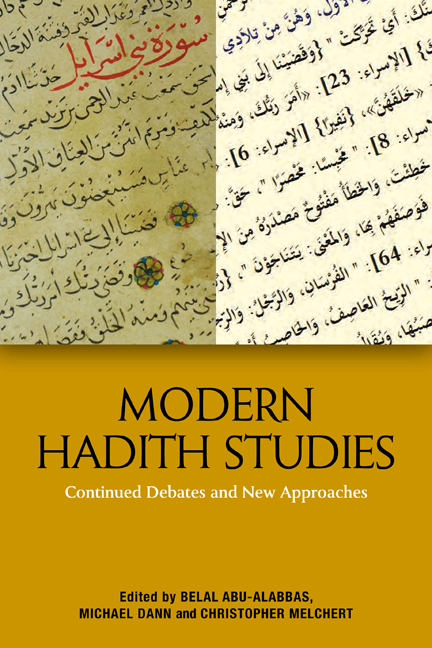Book contents
- Frontmatter
- Contents
- Figures and Tables
- Acknowledgements
- Note on Conventions
- Notes on Contributors
- Introduction
- 1 Kunnā nakrahu al-kitāb: Scripture, Transmission of Knowledge, and Politics in the Second Century AH (719–816 ce)
- 2 The History of the Adhān: a View from the Hadith Literature
- 3 Ibn al-Mubārak, Traditionist
- 4 Early ‘Traditionist Sufis’: A Network Analysis
- 5 The Common Link and its Relation to Hadith Terminology
- 6 Hadith Criticism between Traditionists and Jurisprudents
- 7 Hadith Criticism in the Levant in the Twentieth Century: From ẓāhir al-isnād to ʿilal al-ḥadīth
- 8 The Reception and Representation of Western Hadith Studies in Turkish Academe
- 9 Can Different Questions Yield the Same Answers? Islamic and Western Scholarship on Shiʿi Narrators in the Sunni Tradition
- Index
5 - The Common Link and its Relation to Hadith Terminology
Published online by Cambridge University Press: 01 October 2020
- Frontmatter
- Contents
- Figures and Tables
- Acknowledgements
- Note on Conventions
- Notes on Contributors
- Introduction
- 1 Kunnā nakrahu al-kitāb: Scripture, Transmission of Knowledge, and Politics in the Second Century AH (719–816 ce)
- 2 The History of the Adhān: a View from the Hadith Literature
- 3 Ibn al-Mubārak, Traditionist
- 4 Early ‘Traditionist Sufis’: A Network Analysis
- 5 The Common Link and its Relation to Hadith Terminology
- 6 Hadith Criticism between Traditionists and Jurisprudents
- 7 Hadith Criticism in the Levant in the Twentieth Century: From ẓāhir al-isnād to ʿilal al-ḥadīth
- 8 The Reception and Representation of Western Hadith Studies in Turkish Academe
- 9 Can Different Questions Yield the Same Answers? Islamic and Western Scholarship on Shiʿi Narrators in the Sunni Tradition
- Index
Summary
The ‘common link’ is not a newly coined term. Its history goes back to the middle of the twentieth century when Joseph Schacht first used it. Schacht, who was mainly concerned with the dating of hadiths, discovered a peculiar phenomenon in their isnāds: the ‘common transmitters’. If different isnāds of a given hadith are gathered and put together, almost all of them meet at a certain point at a common transmitter, whom he named the ‘common link’, and then through a single strand reach back to an authority such as a Companion or the Prophet himself. According to Schacht, ‘the existence of a significant common link (N.N.) in all or most isnāds of a given tradition would be a strong indication in favour of its having originated in the time of N.N.’. In other words, he believed that drawing on information obtained through the common link one can identify the origin of that particular hadith in terms of time and place. From his time onwards, ‘the common link’ has played a prominent role in modern hadith studies and has been used by those scholars who would date hadiths based on isnād analysis.
But was this phenomenon recognised by Muslim hadith scholars and traditionists (muḥaddithūn), and can one find some traces of this recognition in the Islamic hadith literature as well? Hadith scholars have coined a plethora of technical terms (muṣṭalaḥāt al-ḥadīth) to define the various features of hadiths and the qualifications of their transmitters. Is it possible to find amongst them some terms that, in one way or another, correspond to the common link or be considered as its equivalent?
In his prominent study, Schacht notices that Muslim hadith scholars already recognised this phenomenon:
It was observed, though of course not recognised in its implications, by the Muhammadan scholars themselves, for instance by al-Tirmidhī in the concluding chapter of his collection of traditions. He calls traditions with N.N. as a common link in their isnāds ‘the traditions of N.N.’, and they form a great part of the traditions which he calls gharīb, that is transmitted by a single transmitter at any stage of the isnād.
- Type
- Chapter
- Information
- Modern Hadith StudiesContinuing Debates and New Approaches, pp. 97 - 128Publisher: Edinburgh University PressPrint publication year: 2020



